Truck ergonomics
Page 48
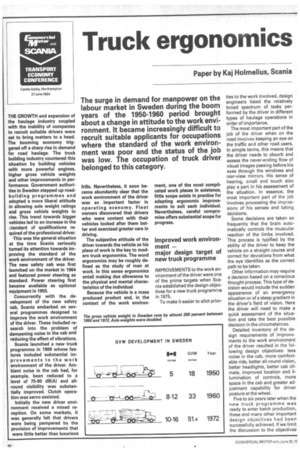
Page 49
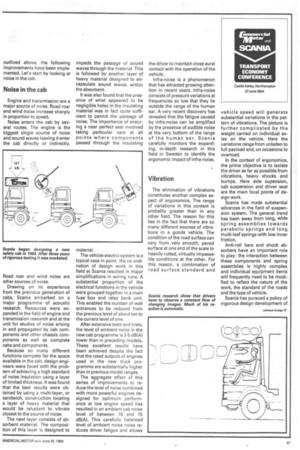
Page 52
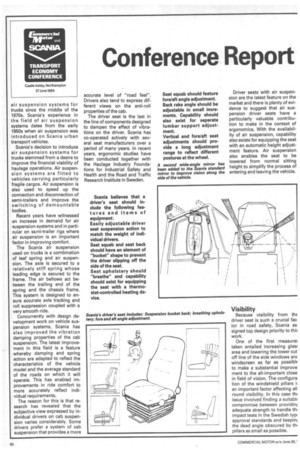
Page 53
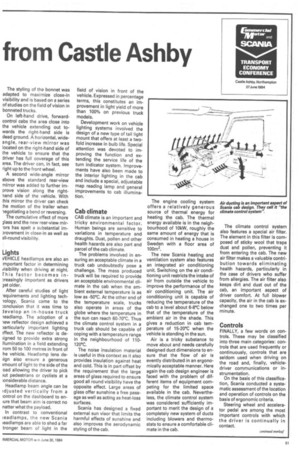
Page 54

Page 55
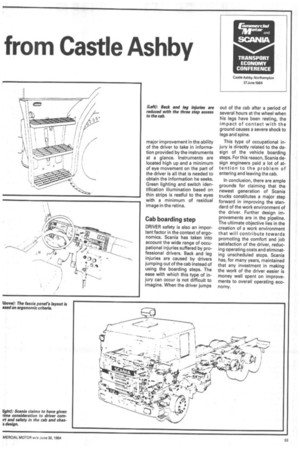
If you've noticed an error in this article please click here to report it so we can fix it.
Paper by Kaj Holmelius, Scania The surge in demand for manpower on the labour market in Sweden during the boom years of the 1950-1960 period brought about a change in attitude to the work enviironment. It became increasingly difficult to recruit suitable applicants for occupations where the standard of the work environment was poor and the status of the job was low. The occupation of truck driver belonged to this category.
THE GROWTH and expansion of the haulage industry coupled with the inability of companies to recruit suitable drivers were set to bring matters to a head. The booming economy triggered off a sharp rise in demand for road haulage. The truck building industry countered this situation by building vehicles with more powerful engines, higher gross vehicle weights and other improvements in performance. Government authorities in Sweden stepped up roadbuilding programmes and adopted a more liberal attitude in allowing axle weight ratings and gross vehicle weights to rise. This trend towards bigger vehicles led to an increase in the &tandard of qualifications required of the professional driver.
This was the general situation at the time Scania seriously turned its attention towards improving the standard of the work environment of the driver. The new safety cab was first launched on the market in 1964 and featured power steering as standard. Power steering first became available as optional equipment in 1955.
Concurrently with the development of the new safety cab, Scania embarked on several programmes designed to improve the work environment of the driver. These included research into the problem of dampening noise in the cab and reducing the effect of vibrations.
Scania launched a new truck programme in 1968 whose features included substantial improvements to the work environment of the driver. Ambient noise in the cab had, for example, been reduced to a level of 75-80 dB(A) and allround visibility was substantially improved. Clutch operation was servo assisted.
Initially the new driver environment received a mixed reception. On some markets, it was generally felt that drivers were being pampered by the provision of improvements that were little better than luxurious frills. Nevertheless, it soon became abundantly clear that the work environment of the driver was an important factor in operating ecenomy. Fleet owners discovered that drivers who were content with their vehicles looked after them better and exercised greater care in driving.
The subjective attitude of the driver towards the vehicle as his place of work is the key to modern truck ergonomics. The word ergonomics may be roughly defined as the study of man at work. In this sense ergonomics entail making due allowance to the physical and mental characteristics of the individual.
Because the vehicle is a mass produced product and, in the context of the work environ ment, one of the most complicated work places in existence, little scope exists in practice for adapting ergonomic improvements to suit each individual. Nevertheless, careful compromise offers substantial scope f or progress.
Improved work environment — major design target of new truck programme
IMPROVEMENTS to the work environment of the driver were one of the prime targets when Scania established the design objectives for a new truck programne in 1975.
To make it easier to allot prior ties to the work involved, design engineers listed the relatively broad spectrum of tasks performed by the driver in different types of haulage operations in order of importance.
The most important part of the job of the driver when on the road involves keeping an eye on the traffic and other road users. In simple terms, this means that the driver needs to absorb and assess the never-ending flow of visual images passing before his eyes through the windows and rear-view mirrors. His sense of hearing, smell and touch also play a part in his assessment of the situation. In essence, the most important part of the job involves processing the impressions of his senses and taking decisions.
Some decisions are taken so frequently that the brain automatically controls the muscular reaction of the limbs involved. This process is typified by the ability of the driver to keep the vehicle on a straight course and correct for deviations from what the eye identifies as the correct path to be taken.
Other information may require a decision based on a conscious thought process. This type of decision would include the sudden appearance of an emergency situation or of a steep gradient in the driver's field of vision. Here the driver will need to make a quick assessment of the situation and take the best possible decision in the circumstances.
Detailed inventory of the design requirements of improve ments to the work environment of the driver resulted in the following design objectives: less noise in the cab, more comfortable ride, better all-round vision, better headlights, better cab climate, improved location and illumination of controls, more space in the cab and greater adjustment capability for driver posture at the wheel.
Five to six years later when the new truck programme was ready to enter batch production, these and many other important design objectives had been successfully achieved. If we limit the discussion to the objectives outlined above, the following improvements have been implemented. Let's start by looking at noise in the cab.
Noise in the cab
Engine and transmission are a major source of noise. Road roar and wind noise increase sharply in proportion to speed.
Noise enters the cab by several routes. The engine is the biggest single source of noise and sound waves leaving it enter the cab directly or indirectly.
Road roar and wind noise are other sources of noise.
Drawing on its experience from the previous generation of cabs, Scania embarked on a major programme of acoustic research. Resources were expanded in the field of engine and transmission research and at the unit for studies of noise arising in and propagated by cab components and other chassis components as well as complete cabs and components.
Because so many different functions compete for the space available in the cab, design engineers were faced with the problem of achieving a high standard of noise insulation using a layer of limited thickness, It was found that the best results were obtained by using a multi-layer, or sandwich, construction locating a layer of heavy material that would be reluctant to vibrate closest to the source of noise.
The next layer consists of absorbent material. The composition of this layer is designed to impede the passage of sound waves through the material. This is followed by another layer of heavy material designed to encapsulate sound waves within the absorbent.
It was also found that the presence of what appeared to be negligible holes in the insulating material was in fact quite sufficient to permit the passage of noise. The importance of ensuring a near perfect seal involved taking particular care at all points where components passed through the insulating material.
The vehicle electric system is a typical case in point: the co-ordination of design work in this field at Scania resulted in major simplifications in wiring runs. A substantial proportion of the electrical functions in the vehicle were grouped together in a main fuse box and relay bank unit. This enabled the number of wall entrances to be reduced from the previous level of about ten to the current level of one.
After extensive tests and trials, the level of ambient noise in the new cab programme is 3-5 dB(A) lower than in preceding models. These excellent results have been achieved despite the fact that the rated outputs of engines used in the new truck programme are substantially higher than in previous model ranges.
The aggregate effect of this series of improvements to reduce the level of noise combined with more powerful engines designed for optimum performance at low engine speed has resulted in an ambient cab noise level of between 70 and 75 dB(A). This carefully balanced level of ambient noise noise reduces driver fatigue and allows the driver to maintain close aural contact with the operation of the vehicle.
Infra-noise is a phenomenon that has attracted growing attention in recent years. Infra-noise consists of pressure variations at frequencies so low that they lie outside the range of the human ear. A very recent discovery has revealed that the fatigue caused by infra-noise can be amplified by the presence of audible noise at the very bottom of the range of the human ear. Scania carefully monitors the expanding, in-depth research in this field in Sweden to identify the ergonomic impact of infra-noise.
Vibration
The elimination of vibrations constitutes another complex aspect of ergonomics. The range of variations in this context is probably greater than in any other field. The reason for this lies in the fact that there are so many different sources of vibrations in a goods vehicle. The condition of the road surface can vary from very smooth, paved surface at one end of the scale to heavily rutted, virtually impassable conditions at the other. For this reason, a combination of road surface standard and vehicle speed will generate substantial variations in the pattern of vibrations. The picture is further complicated by the weight carried on individual axles on the vehicle. Here the variations range from unladen to full payload and, on occasions to overload.
In the context of ergonomics, the prime objective is to isolate the driver as far as possible from vibrations, heavy shocks and bumps. Here ale supension, cab suspension and driver seat are the main focal points of design work.
Scania has made substantial advances in the field of suspension system. The general trend has been away from long, wide spring assemblies towards parabolic springs and long multi-leaf springs with low inner friction.
Anti-roll bars and shock absorbers have an important role to play: the interaction between these components and spring assemblies is highly complex and individual equipment items will frequently need to be modified to reflect the nature of the work, the standard of the roads and the type of vehicle.
Scania has pursued a policy of vigorous design development of air suspension systems for trucks since the middle of the 1970s. Scania's experience in the field of air suspension systems dates from the early 1950s when air suspension was introduced on Scania urban transport vehicles.
Scania's decision to introduce air suspension systems for trucks stemmed from a desire to improve the financial viability of haulage operations. Air suspension systems are fitted to vehicles carrying particularly fragile cargos. Air suspension is also used to speed up the connection and disconnection of semi-trailers and improve the switching of demountable bodies.
Recent years have witnessed an increase in demand for air suspension systems and in particular on semi-trailer rigs where air suspension is an important factor in improving comfort.
The Scania air suspension used on trucks is a combination of leaf spring and air suspension. The axle is secured to a relatively stiff spring whose leading edge is secured to the frame. The air bellows act between the trailing end of the spring and the chassis frame. This system is designed to ensure accurate axle tracking and roll suppression coupled with a very smooth ride.
Concurrently with design development work on vehicle suspension systems, Scania has also improved the vibration damping properties of the cab suspension. The latest improvement in this field is a feature whereby damping and spring action are adapted to reflect the characteristics of the vehicle model and the average standard of the roads on which it will operate. This has enabled improvements in ride comfort to more accurately reflect individual requirements.
The reason for this is that research has revealed that the subjective view expressed by individual drivers on cab suspension varies considerably. Some drivers prefer a system of cab suspension that provides a more accurate level of "road feel". Drivers also tend to express different views on the anti-roll properties of the cab.
The driver seat is the last in the line of components designed to dampen the effect of vibrations on the driver. Scania has co-operated actively with several seat manufacturers over a period of many years. In recent years, ergonomic studies have been conducted together with the Haulage Industry Foundations for Industrial Safety and Health and the Road and Traffic Research Institute in Sweden. Seat squab should feature fore/aft angle adjustment. Back rake angle should be adjustable in small increments. Capability should also exist for separate lumbar support adjustment.
Vertical and fore/aft seat adjustments should provide a long adjustment range to reflect different postures at the wheel. Driver seats with air suspension are the latest feature on the market and there is plenty of evidence to suggest that air suspension driver seats have a particularly valuable contribution to make in the context of ergonomics. With the availability of air suspension, capability also exists for equipping the seat with an automatic height adjustment feature. Air suspension also enables the seat to be lowered from normal sitting height to simplify the process of entering and leaving the vehicle.
Visibility
Because visibility from thE driver seat is such a crucial fac. tor in road safety, Scania as signed top design priority to thi: work.
One of the first measure: taken entailed increasing glas: area and lowering the lower cut off line of the side windows anc windscreen as far as possiblE to make a substantial improve ment to the all-important close in field of vision. The configure tion of the windshield pillars an important factor affecting all round visibility. In this case thE issue involved finding a suitabli compromise between providini adequate strength to handle thi impact tests in the Swedish typ4 approval standards and keepim the dead angle obscured by thi pillars as small as possible. The styling of the bonnet was adapted to maximize close-in visibility and is based on a series of studies on the field of vision in bonneted trucks.
On left-hand drive, forwardcontrol cabs the area close into the vehicle extending out towards the right-hand side is dead ground. A horizontal, wideangle, rear-view mirror was located on the right-hand side of the vehicle to ensure that the driver has full coverage of this area. The driver can, in fact, see right up to the front wheel.
A second wide-angle mirror above the standard rear-view mirror was added to further improve vision along the rightland side of the vehicle. With his mirror the driver can check :he motion of the trailer when legotiating a bend or reversing.
The cumulative effect of more 3Iass and the new rear-view mir.ors has spelt a substantial improvement in close-in as well as all-round visibility.
Lights
VEHICLE headlamps are also an mportant factor in determining risibility when driving at night. rhis factor becomes in reasingly important as drivers jet older.
After careful studies of light -equirements and lighting techScania came to the
;onclusion that it was time to levelop an in-house truck leadlamp. The adoption of a tew reflector design achieved a mrticularly important lighting Med. The new reflector is de igned to provide extra strong Ilumination in a field extending rom 50 to 100 metres in front of he vehicle. Headlamp lens deign also ensure a generous !mount of light to the side of the oad allowing the driver to pick nit pedestrians or cyclists at a onsiderable distance.
Headlamp beam angle can be idjusted vertically from a :ontrol on the dashboard to enure that beam aim is correct no natter what the payload.
In contrast to conventional leadlamps, the new Scania leadlamps are able to shed a far tronger beam of light in the field of vision in front of the vehicle. Expressed in percentage terms, this constitutes an improvement in light yield of more than 100% on previous truck models.
Development work on vehicle lighting systems involved the design of a new type of tail light mount that offers at least a twofold increase in bulb life. Special attention was devoted to improving the function and extending the service life of the turn indicator system. Improvements have also been made to the interior lighting in the cab and include a special, adjustable map reading lamp and general improvements to cab illumination.
Cab climate
CAB climate is an important and tricky environmental factor. Human beings are sensitive to variations in temperature and draughts. Dust, pollen and other health hazards are also part and parcel of the cab climate.
The problems involved in ensuring an acceptable climate in a truck cab undoubtedly pose a challenge. The mass produced truck will be required to provide an acceptable environmental climate in the cab when the ambient external temperature is as low as -50°C. At the other end of the temperature scale, trucks also operate in areas of the globe where the temperature in the sun can reach 60-70°C. Thus the climate control system in a truck cab should be capable of coping with a temperature range in the neighbourhood of 110120°C.
The noise insulation material is useful in this context as it also provides insulation against heat and cold. This is in part offset by the requirement that the large areas of glass required to ensure good all round visibility have the opposite effect. Large areas of glass offer sunshine a free passage as well as acting as heat-loss surfaces.
Scania has designed a fixed external sun visor that limits the harmful effects of sunshine and also improves the aerodynamic styling of the cab.
The engine cooling system offers a relatively generous source of thermal energy for heating the cab. The thermal energy available is in the neighbourhood of 10kW, roughly the same amount of energy that is consumed in heating a house in Sweden with a floor area of 100m2.
The new Scania heating and ventilation system also features an integrated air conditioning unit. Switching on the air conditioning unit restricts the intake of air from outside the vehicle to improve the performance of the air conditioning unit. The air conditioning unit is capable of reducing the temperature of the cab to a level about 6-8°C below that of the temperature of the ambient air in the shade. This gives a reduction in cab temperature of 15-20°C when the vehicle is standing in the sun.
Air is a tricky substance to move about and needs carefully designed duct dimensions to ensure that the flow of air is evently distributed in an ergonomically acceptable manner. Here again the cab design engineer is faced with the problem of different items of equipment competing for the limited space available in the cab. Nevertheless, the climate control system was considered sufficiently important to merit the design of a completely new system of ducts including blowers and thermostats to ensure a comfortable climate in the cab.
The climate control system also features a special air filter. The element in this filter is composed of sticky wool that traps dust and pollen, preventing it from entering the cab. The new air filter makes a valuable contribution towards eliminating health hazards, particularly in the case of drivers who suffer from allergies. The air filter also keeps dirt and dust out of the cab, an important aspect of driver comfort. At full blower capacity, the air in the cab is exchanged one to two times per minute.
Controls
FINALLY, a few words on controls. These may be classified into three main categories: controls that are used frequently or continuously, controls that are seldom used when driving on the road and, finally, vehicledriver communications or instrumentation.
On the basis of this classification, Scania conducted a systematic assessment of the location and operation of controls on the basis of ergonomic criteria.
Steering wheel and accelerator pedal are among the most important controls with which the driver is continually in contact. The location of the steering wheel is particularly important in light of the fact that, together with the adjustment capability offered by the driver's seat, it is a major factor in determining posture at the wheel.
Because there is such a wide divergence of opinion among drivers as to what constitutes a comfortable posture at the wheel, Scania design engineers elected to offer two options — fixed and adjustable steering wheel. The adjustable steering wheel features an adjustable steering column height in intervals of 40 mm. Steering wheel rake may be adjusted at five settings ranging from 200 to 470. Steering wheel rake adjustment is particularly important in enabling the driver to adjust to the most comfortable wrist angle in the hands-on position.
Accelerator pedal depression has a carefully balanced, adjustable level of spring resistance to ensure that leg muscles are not subjected to any strain when the driver is at the wheel for long periods. Pedal angle is designed to offer a comfortable foot angle when driving at normal speeds. Brake pedal height is on a level with accelerator pedal depression at normal cruising speeds. This enables the brakes to be applied by a quick and convenient twist of the foot.
Gearstick and clutch are classified in the next use frequency category of controls, By using a clutch servo and a special clutch function, Scania has designed an easy-action clutch pedal operation with a permanent take-up position.
The problem involved in designing the gearstick and its area of operation on the basis of ergonomic criteria is more difficult. This is partly due to the fact that quite a lot of gear changing force is required to achieve synchronization. For this reason, a compromise must be struck between the leverage ratio involved in the movement of the gearstick from one gear to another and the physical effort involved in changing gear.
The high output and torque developed by Scania engines make a valuable contribution to taking the hard work out of gear changing by keeping the number of gear changes at a minimum.
Scania recently unveiled a major engineering breakthrough in the problem of changing gear. Scania has designed a computer-aided gear changing system as an alternative to the conventional gearstick method. Using the new equipment, the work of changing gear has been reduced to the level where the driver only needs to change gear when he wishes to select a gear other than that recommended by the computer. In such cases all he needs to do is to use a small, easy-to-reach selector stick to engage the gear of his choice.
This new gear changing technology is based on modern electronics. Sensors are used to monitor engine load, vehicle road speed and the gear engaged and a computer calculates the most fuel-efficient gear to be engaged in any given traffic situation.
As soon as the situation has changed sufficiently to warrant the engagement of another gear, the computer presents its gear proposal on a display on the dashboard in front of the driver.
Because the driver is in a position to assess the traffic situation well ahead of the vehicle, the system is based on leaving the ultimate decision as to which gear shall be engaged and when up to the driver. If the driver accepts the gear proposal submitted by the computer, all he need do is to depress the clutch and the new gear will be engaged automatically.
If the driver rejects the computer proposal in favour of another gear, he can change up or change down by operating the gear selector once for each gear change. There is no danger of damaging the transmission or engine through over-revving as the system includes a safety feature to override this sort of situation.
From an ergonomic point of view, computer-aided gear changing offers an opportunity of relieving the driver of a substantial burden of physical and mental strain. All routine gear changing with the gearstick is eliminated. The driver can easily and safely intervene to override the computer decision by operating the small selector stick. The Scania computeraided gear changing system is programmed to optimise fuel consumption, a fact that should do much to improve the driver's sense of job satisfaction and professional pride in his work.
The location and design of hand throttle, parking brake, stop control and other controls in the new Scania cabs are based on ergonomic criteria. Such controls point towards the driver for more accurate ease of operation.
The classification of instruments on the basis of importance coupled with a careful study of their location has spelt a
major improvement in the ability of the driver to take in information provided by the instruments at a glance. Instruments are located high up and a minimum of eye movement on the part of the driver is all that is needed to obtain the information he seeks. Green lighting and switch identification illumination based on thin strips is restful to the eyes with a minimum of residual image in the retina.
Cab boarding step
DRIVER safety is also an important factor in the context of ergonomics. Scania has taken into account the wide range of occupational injuries suffered by professional drivers. Back and leg injuries are caused by drivers jumping out of the cab instead of using the boarding steps. The ease with which this type of injury can occur is not difficult to imagine. When the driver jumps out of the cab after a period of several hours at the wheel when his legs have been resting, the impact of contact with the ground causes a severe shock to legs and spine.
This type of occupational injury is directly related to the design of the vehicle boarding steps. For this reason, Scania design engineers paid a lot of attention to the problem of entering and leaving the cab.
In conclusion, there are ample grounds for claiming that the newest generation of Scania trucks constitutes a major step forward in improving the standard of the work environment of the driver. Further design improvements are in the pipeline. The ultimate objective lies in the creation of a work environment that will contribute towards promoting the comfort and job satisfaction of the driver, reducing operating costs and eliminating unscheduled stops. Scania has, for many years, maintained that any investment in making the work of the driver easier is money well spent on improvements to overall operating economy.






















































































